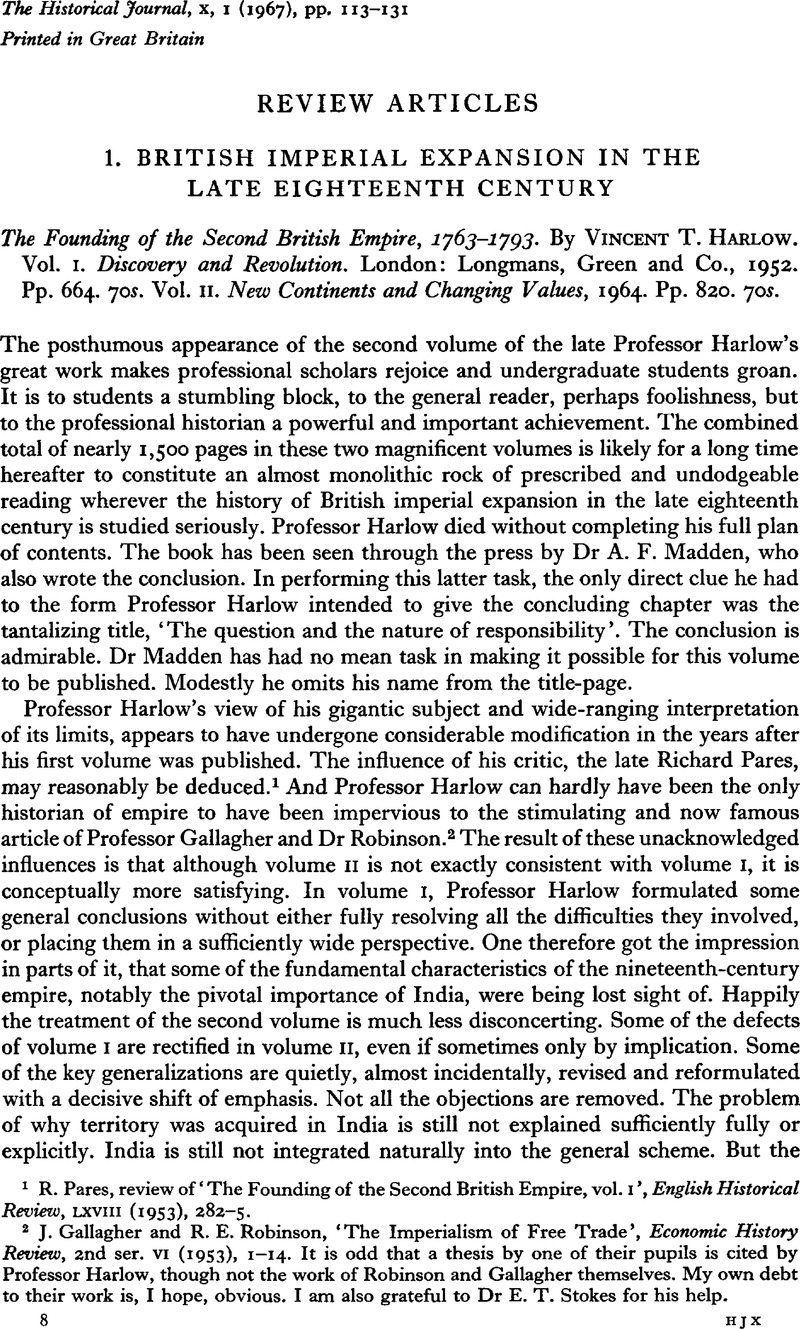Published online by Cambridge University Press: 09 December 2010

1 Pares, R., review of ‘The Founding of the Second British Empire, vol. 1’, English Historical Review, LXVIII (1953), 282–5.CrossRefGoogle Scholar
2 Gallagher, J. and Robinson, R. E., ‘The Imperialism of Free Trade’, Economic History Review, 2nd ser. VI (1953), 1–14CrossRefGoogle Scholar . It is odd that a thesis by one of their pupils is cited by Professor Harlow, though not the work of Robinson and Gallagher themselves. My own debt to their work is, I hope, obvious. I am also grateful to Dr E. T. Stokes for his help.
3 Morley to Minto, 2 May 1907, India Office Library, MSS. Eur. D. 573/2/91-2.
4 Marshall, P., ‘The First and Second British Empires: a question of demarcation’, History, XLIV (1964), 23.Google Scholar
5 , Gallagher and , Robinson, loc. cit. p. 13.Google Scholar
6 Gipson, L. H., The British Empire before the American Revolution, vol. VIII: The Great War for the Empire: the culmination 1760-1763 (New York, 1954), p. 106.Google Scholar
7 Davies, K. G., The Royal African Company (1957), pp. 2–6.Google Scholar
8 , Pares, loc. cit. p. 284.Google Scholar
9 Graham, G. S., British Policy and Canada 1774-1791 (1930), IX, 132.Google Scholar
10 Manning, H. T., British Colonial Government after the American Revolution 1782-1820 (New Haven, 1933), pp. 9-10, 292Google Scholar . See also Armytage, F., The Free Port System in the British West Indies 1766-1822 (1953), pp. 12–13Google Scholar.
11 Graham, G. S., Empire of the North Atlantic (Toronto, 1950), p. 268.Google Scholar
12 Schlote, W., British Overseas Trade (1952 transl.), pp. 79–80.Google Scholar
13 Tables derived from Mitchell, B. R. and Deane, P., Abstract of British Historical Statistics (1962), p. 312.Google Scholar
14 Ward, W. R. in New Cambridge Modem History (1965), VIII, 555Google Scholar
15 Wright, H. R. C., East Indian Economic Problems in the age of Cornwallis and Raffles (1961), pp. 294–6.Google Scholar
16 Tarling, N., Piracy and Politics in the Malay World (Melbourne, 1963), p. 12.Google Scholar
17 Mrs Nightingale, P., ‘British Commercial Interests and the Expansion of the Bombay Presidency, 1784-1806’ (unpublished Cambridge University Ph.D. dissertation, 1964), pp. 314–16.Google Scholar
18 Fieldhouse, D., ‘British Imperialism in the Late 18th Century’, Essays in Imperial Government presented to Margery Perham, ed. Madden, A. F. and Robinson, K. (1963).Google Scholar
19 Beer, G. L., British Colonial Policy, 1754-1765 (New York, 1907), p. 139.Google Scholar
20 Quoted in Gipson, L. H., The British Empire before the American Revolution, vol. ix, The Triumphant Empire, 1763-1766 (New York, 1956), p. 41Google Scholar . See also The Founding of the Second British Empire, 1, 138.
21 The Parliamentary History of England to 1803, vol. XV, 1753-1765 (1813)Google Scholar , ‘The principal arguments which were offered in favour of the treaty’, p. 1272.
22 The Annual Register for 1762, p. 56.
23 Wallace, W. S., ‘The Beginnings of British Rule in Canada’, Canadian Historical Review, IV (Toronto, 1925), 208.Google Scholar
24 , Graham, British Policy and Canada, p. 9.Google Scholar
25 Almon, J., A Review of Mr Pitt's Administration (4th ed. 1764), p. vGoogle Scholar ; H. McCullo[c]h, Miscellaneous Representations relative to our concerns in America (1761, ed. Shaw, W. A., [n.d.,? 1905]), p. 6Google Scholar ; The North Briton, p. xxiv, 13 11 1762Google Scholar.
26 Quoted in T. C. Pease, Anglo-French Boundary Disputes in the West, 1749-1763 (Collections of the Illinois State Historical Library, XXVII, 1936, 411-12). Hardwicke was quite right about the fur trade: Lawson calculates that during the period 1700-75 fur and hats played an insignificant role in the total English and colonial economy; imports of fur accounted for under ½ per cent of the total value of English imports: the exports of fur under ¼ per cent, and of fur hats under 1¼ per cent: Lawson, M. G., Fur: a Study in English Mercantilism, 1700-1775 (Toronto, 1943), p. 70Google Scholar.
27 , Pease, op. cit. pp. 436–7.Google Scholar
28 Mowat, C. L., East Florida as a British Province, 1763-84 (University of California Publications in History, XXXII, 1943, 7)Google Scholar ; Lyon, E. W., Louisiana in French Diplomacy, 1759-1804 (Norman, 1943), pp. 27–8Google Scholar.
29 Harlow, V. T., ‘Cape Colony, 1806-1822’, Cambridge History of the British Empire, VIII (1936), 196Google Scholar . For criticism see Turner, L. C. F., ‘The Cape of Good Hope and Anglo-French Conflict, 1797-1806’, Historical Studies, Australia and New Zealand, IX (1961)Google Scholar.
30 See , Marshall, History, XLIV (1964)Google Scholar : land settlement in Nova Scotia, New York, Quebec, and Florida increased rapidly; West Indian estates commanded higher prices in 1775 than 1765; there was quite a deep penetration into Tibet 1772-74 to keep open the land route to China.
31 These characteristics included the retention of a mercantilist element. Robinson, R. E. and Gallagher, J., Africa and the Victorians (1961), pp. 22Google Scholar: the later Victorians inherited a tradition of policy that ‘had come down unbroken from Pitt and Canning to Palmerston and Clarendon’. It is interesting to note that one of the Victorian habits, using India as ‘a battering ram’, launching expeditions for imperial and commercial purposes from India, had begun as early as 1762/63, with the seizure of Manila (Ballard, G. A., ‘Anglo-French contacts in the Indian Ocean’, Mariner's Mirror, XIII, 1927)Google Scholar.